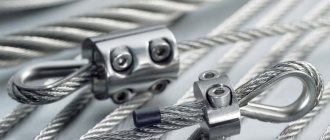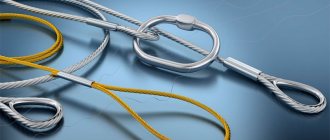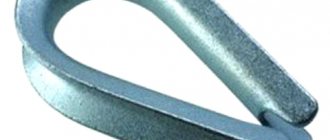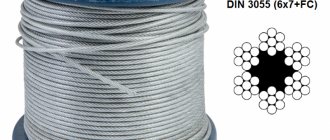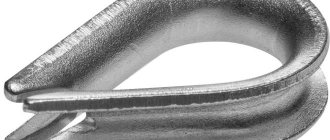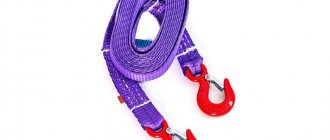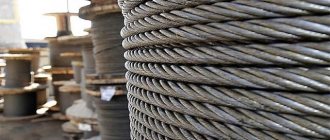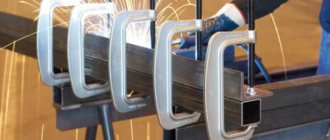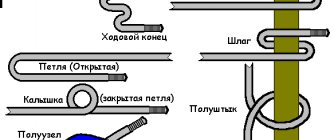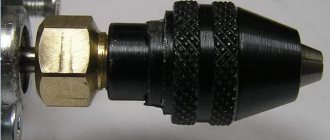Perhaps you need:
Cable clamp DIN 741 8mm
More details
Simplex cable clamp 5mm
More details
Duplex cable clamp 6mm
More details
The main purpose of the clamps is:
- installation of overhead cable lines;
- lengthening (splicing) of cables;
- creation of loops and eyes reinforced with thimbles;
- connection of cables at right angles;
- locking elements on the cable;
- attaching a collet clamp with an eye to the cable.
All these actions provide the required tension when installing and securing structures and loads in construction, transportation, rescue and special operations.
Types of clamping devices
Let's look at the most popular types of cable clamps.
Bracket
Another name for the product is cable clamp DIN 741. It is available for cables with a diameter of 4 to 19 mm. Consists of a forged or stamped base with holes and a U-shaped steel clamp with threaded ends. One or two cables are compressed with two nuts, and locking washers are used for locking.
To enhance the breaking load on one connection, up to three staples are used. It is reusable, meaning it can be easily and quickly assembled and disassembled. It is this property, together with the low price, that has ensured the widespread use of the bracket. The disadvantage is the small clamping area, which is fraught with cutting deformation of the cable when excessive force is applied to tighten the nuts.
Cam clamp
According to the coupling pattern with the cable line, this product is similar to the previous bracket. It has an equally small contact area, so it is often used in double or triple versions. Another disadvantage is the high cost.
Flat single clamp SIMPLEX
Consists of a flat support with a threaded rod and a pressure plate, available for cables with a diameter of 2 to 8 mm. All parts of this product are made from carbon steel and coated with zinc to protect against corrosion. The manufacturing method is stamping, which makes the unit inexpensive. The contact area of the sling with the clamping parts is much larger than in the bracket. High compression force allows reliable elongation or loop creation.
Flat double clamp DUPLEX
An even stronger connection or extension of the ends is created by the DUPLEX double flat clamp, also called a saddle clamp. The clamping area is twice that of SIMPLEX. The advantages of flat products are greater clamping efficiency, ease of connection and low cost. They are widely used in guying high masts, antennas and other tall structures.
Rigging shackle
It is a U-shaped arc with two holes for a threaded pin. Manufactured in two versions:
- The pin is locked by screwing into the thread on the arc.
- A castle nut is screwed onto the pin and secured with a cotter pin.
This product is made of durable carbon steel with zinc coating. It is used in detachable connections of cables, belts, ropes in the construction, shipbuilding, transportation and mountaineering fields. The minimum pin diameter is 5 mm.
Cable end DIN3093
Other names include tubular, disposable clamp, and sleeve. It is made in the form of a thick-walled tube with an oval internal section, into which two ends are placed. Materials: aluminum, copper and stainless steel. The minimum tip size is 2 mm.
To fix, both ends are inserted into the tip and clamped with a mechanical press or a special crimping tool. The product is disposable, since it is impossible to separate it without destruction. It is used to make loops or extend cables. If you do not take into account the cost of the crimping tool, then this clamp can be considered the cheapest.
Barrel-shaped
It consists of two silumin plates shaped like a barrel. Two cables passed between them are clamped with a screw. The strength of such a clamp is low, so it is used only in lightly loaded systems. Advantages: aesthetic appearance, low weight, streamlined design, ease of creating a connection or loop.
Cross
In cases where two cables need to be secured at an angle of 90º, a clamp is used, consisting of a sleeve with grooves for the cables and a screw pin with an internal hexagon. It is not durable, but is convenient for creating a coarse mesh of cables and similar spatial structures.
Spot
It is also called flatbed and bus. The product consists of two parts connected by bolts. The lower one resembles the letter W, the upper one resembles half a pipe section. The contact surfaces of the ends are corrugated, which increases friction during pressing. This type of clamp is considered high-strength; an additional advantage is that its parts do not damage the cables. The disadvantage is the high price.
Cylindrical
It consists of two half rings connected by bolts, and is made only for small diameter cables (3-4 mm). The product is suitable for locking parts and structures at a certain point on the cable. The cylindrical clamp is convenient for creating cable structures. The disadvantage is the high price.
Stopper
It is similar to the previous one, but differs from it in design. The product is designed to be locked on a cable to prevent sliding of parts and assemblies attached to it. The locking clamp is rarely used and has a high price.
Collet
This type of clamp is designed to attach an easy-to-install fork with a pin to the end of the sling. The collet is clamped with a hex nut. The strength of the connection is low; the main advantage of such a product is its ease of use in lightly loaded systems. The price of the clamp is quite high, so it is rarely used.
Klinova
This product is mainly used in mountaineering. The cable is firmly clamped by two eccentrics when a load is applied to the fastening ring (right in the photo). The wedge clamp is designed for hanging loads from vertical cables.
Braiding and crimping of rope slings - Behind the scenes
According to GOST 25573-82 and RD 10-33-93, there are two methods for manufacturing slings from steel rope, which are structurally different from each other:
- Braiding of rope slings - manual braiding of the ends of the rope;
- Crimping of slings with a sleeve - sealing the ends by crimping a rope with an aluminum sleeve - tube. In everyday life this method is called tuning.
Braiding steel ropes
- Manual cable braiding - we weave strands of the unraveled end of the steel rope between the strands of the unraveled rope.
Manufacturer of slings - Strop-Arsenal Company produces steel rope slings GOST 25573-82 using the braiding method in accordance with the requirements of GOST and RD 10-33-93:
- for the production of cargo rope slings we use only new steel ropes with a testing certificate from the manufacturer;
- the number of punctures of the rope by strands when braiding slings, as well as braiding ropes onto a thimble, corresponds to the guidelines of GOSGORTEKHNADZOR OF RUSSIA RD 10-33-93 and RD 10-231-98 - (clause 2.4.3)
- the braided section of the rope is tapped manually with a sledgehammer;
- correct braiding of the rope - no protruding ends of the wires
When making slings using the hand-braiding method, we protect the place of the weave so that the slinger does not injure his hands. Just as when braiding a cable onto a thimble, the Strop-Arsenal Company offers 2 ways to isolate the place where the strands are intertwined when braiding a steel cable:
- winding the braided section with soft wire (bandage) - soft steel wire (bandage), tapered, forms a smooth transition from the braided section to the working diameter of the rope.
- sealing the braided area with heat-shrinkable (heat-shrinkable) tube - the heat-shrinkable tube fits tightly around the braided area.
With both methods of sealing the braided area, the sling is easily removed from under the load and DOES NOT INJURY THE SLINGER’S HANDS WITH PROTECTING WIRES.
Sling crimping - Rope slings crimping method
Crimping of slings with a bushing is crimping the ends of steel cables with an aluminum bushing with strands of connected ropes, which are interlocked with the metal of the bushing, forming a homogeneous body in cross-section.
When producing rope slings using crimping, we use a Unisplice 600 hydraulic press made in the UK as a method for sealing rope ends. Maximum press force 600 tons.
The Strop-Arsenal company produces slings from steel rope using the rope crimping method in accordance with GOST 25573-82 and RD 10-33-93:
- For the production of cargo rope slings, we use only new metal ropes with a certificate from the rope manufacturer about their testing
- Aluminum bushings satisfy GOST 25573-82 and RD 10-33-93 - by shape - by design - by grade of aluminum alloys;
Crimping of rope slings
| The tag is pressed into an aluminum tube | Sling crimping process |
Uniform crimping of the steel cable at the point of contact with its end over the entire cross-section of the sleeve.
The bushing turns out to be smooth and cylindrical, with no burrs (burrs) - protecting the slinger’s hands.
A smooth cylindrical bushing and a uniform cross-section at the point where the steel sling is compressed is:
- reliability of sealing rope ends
- guarantee of sling safety during loading and unloading operations
- absence of burrs on the surface of the bushing – does not injure the slinger’s hands.
| TAG on slings - braiding method To mark rope slings, we use a round metal tag 2-3 mm thick, which we weave into one strand of rope. It is securely fixed there. Such a tag does not cling to the lifted load and does not fly off when the sling is pulled out from under the load. | TAG on slings - crimping method To mark rope slings, we use a round metal tag with a thickness of 2-3 mm. Using a metal flagellum, we simultaneously press the tag together with the end of the steel rope into an aluminum sleeve. Thanks to this, the tag is securely fixed to the product. |
For the convenience of customers, when accepting products and issuing them for work, we indicate the following information on each tag:
- manufacturer's trademark;
- serial number of the product according to the numbering of the manufacturer;
- lifting capacity of the sling;
- length of the product;
- test date (month, year)
You can select, order and purchase rope slings in the section of the catalog of lifting slings: “ROPE SLANGS”
How to choose a cable clamp?
The description of the characteristics of each product provides recommendations on how to select a cable clamp. Let us repeat, it is especially important that the diameter of the cable matches the size of the clamp, since failure to comply with this rule may result in failure of the clamp or cable.
The technical specifications also contain information about the magnitude of the loads applied to the clamps. Almost all of the clamps described are not designed for lifting loads (there is special lifting rigging for this). The standard size of the clamp is indicated by markings on the body.
It is also worth paying attention to the operating conditions of the clamps. If products are used in damp environments or outdoors, they must be protected from corrosion.
When selecting a clamp, you must carefully inspect each product. Traces of corrosion, chips, cracks and deformations indicating a partial loss of strength are unacceptable.
Operating rules
Before starting work, you need to check the strength of the rope clamps. After the first application of load on the cable, the tightening torque must be checked again and adjusted if necessary. It is necessary that products are regularly inspected and tested. This is necessary due to the fact that during operation the products are subject to wear and overload, which will lead to deformations and changes in the structure of the material. Rope end clamps should be inspected at least once every six months, and even more often if the products are used in harsh working conditions.
It is not allowed to bend or adjust the shape of the clamp, as this will deteriorate the quality of the product and reduce its ultimate strength.
The following factors can negatively affect the tightness of the clamps on the cable:
- the nut sits tightly on the thread, but not tightly in relation to the jumper;
- the thread is clogged with dirt, oil, and corrosion products, preventing the necessary tightening of the nut.
Instructions for installing clamps
When using the most popular DIN 741 clamp, it is necessary to insert both ends of the cable into the clamp selected for the size of the cable, and insert the thimble into the resulting loop. The clamp should be secured with nuts so that its steel base is on the side of the load-bearing (long) end. For reliability, 2-3 clamps are usually installed in a row. How to fasten the cable clamps in one unit can be clearly seen in the picture below.
The tightening force of the nuts is selected experimentally. After installation, a load test is carried out. If the clamps do not move or cut the cable, then they are installed correctly. Otherwise, adjustments must be made at the moment of tightening. Similar recommendations apply to flat clamps.
If the clamps are used for a long time, the clamping force should be checked periodically. It may change over time due to changes in temperature and humidity.
Installing cable clamps is a critical operation. Compliance with the basic installation rules and full control over the process is the key to the reliability of the entire structure.
